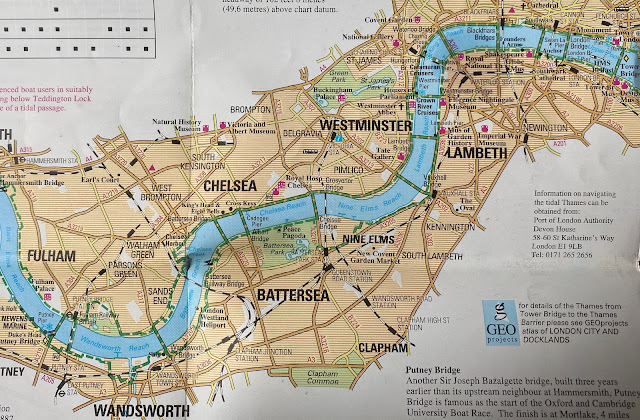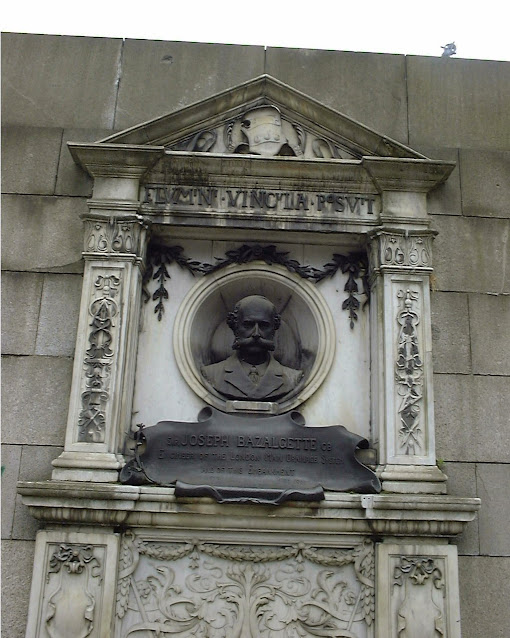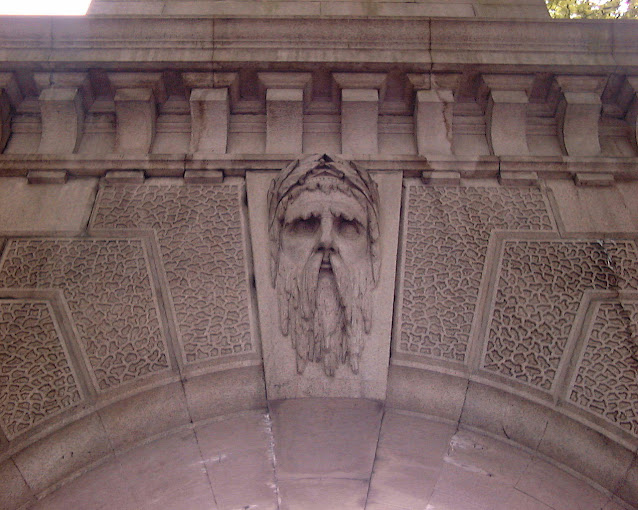Walked June 7, 2002
Today would be a pretty fun day -- walking from my neighborhood to Tower Bridge. It's funny, I know a lot of places along the river between the two, but I had never walked the entire way between them. This post is mainly photos ... lots of photos ...
First I walked to the river and admired Putney Bridge again. It's funny, I crossed this bridge several times a week, but hadn't really looked at it until doing this Thames Path walk.
It's designed by one of my favorite engineers, Sir James Bazalgette -- here's the dedication stone:
This stretch of the river, again, offers choices -- you can walk the ten miles on either bank. I decided to start on the south bank.

I crossed the bridge and headed downstream. One last look at pretty, classic Putney Bridge:
The path took a tiny diversion away from the river, but soon I returned to the bank and looked back upstream to Fulham and Putney Bridge:
Some off-river twists and turns along, I came to the where the Wandle meets the Thames--obviously a very dangerous confluence.
Back on the river I could see-- past ranks of new expensive flats -- an elaborate waste transfer station, where garbage is lifted in containers and loaded onto barges to be shipped elsewhere. I was reminded of Wandsworth's slogan: "The Brighter Borough"
Construction and such meant the path moved away from the river again... but I got back to it across from Chelsea Harbour (an "upmarket township grouped around the marina") and the old Lots Road Power Station:
And then finally came to Battersea Bridge:
... and this creepy statue of Sir Thomas More in the garden:
I walked along Cheyne Walk -- home to dozens of notables in these grand houses near the river, including Dante Gabriel Rosetti, James Macneil Whistler, Elizabeth Gaskell, Isambard Kingdom Brunel and his father, Marc Brunel, T.S. Eliot, J.M.W. Turner, Keith Richards, Mick Jagger and Marianne Faithful, and so many more... One of the grandest buildings is Carlyle Mansions:
Sharp calls this bridge the "prettiest, most delicate of Thames bridges" and notes that it was built "on a rigid-rod principle, the weight being carried by the diagonal stays of wrought iron radiating out from the towers" and that it is very weak. I love this replica warning sign on the bridge:
I walked through Battersea Park, somehow not taking a picture of the London Peace Pagoda. But I continued on to Chelsea Bridge, which I crossed again to get back on the north bank. As I crossed I looked back upstream to Albert Bridge:
Not long after I passed Battersea Power Station, then very much disused and embroiled in debates over what to do with the iconic structure. A theme park? Shops? Houses? It seems that, now, the area has been developed all around it, and the station itself is being turned into a massive campus for Apple. I think.
One of the main reasons I wanted to be on the north bank was to see this statue to poor William Huskisson. Despite being a noted Georgian politician, he has been depicted in a toga. And despite his political work, he's most famous for being the first person killed by a train, when he was struck and run over by George Stephenson's Rocket locomotive.
After leaving Pimlico Gardens, the path went through Crown Reach Riverside Walk, where I spotted these beautiful lightposts:
And, of course, lovely gaudy Vauxhall Bridge, and Vauxhall Cross, home of MI5, next to it.
I love the look of Vauxhall Cross -- it looks like a home for superheroes or supervillains, and as if it had been constructed out of giant Lego bricks.
A bit farther along was Millbank Tower ... in 2002 it was home to political parties and NGOs. It's a Grade II listed building and, apparently, in 2016 a proposal was approved to turn it into a fancy hotel / flat hybrid. I don't have particular feelings about the tower, but I think the base is interesting.
I also had a great view of St. Mary at Lambeth, now run by the Tradescant Trust as a very nice museum of garden history.
Once across the bridge I took the obligatory photo of the Palace of Westminster. Pity about the weather.
And here's a shot of Westminster Bridge and "Big Ben" -- though of course it's NOT a picture of Big Ben, as Big Ben is the name of the bell, which you can't see. The pointy thing with the clock is really just "the clock tower at the Palace of Westminster". The bridge was designed by Thomas Page, with Gothic detailing added Charles Barry (who had designed the Palace of Westminster next door). What I hadn't known was that the original Westminster Bridge (1750) was controversial because the London ferrymen didn't want a new bridge crossing the river -- they wanted the traffic themselves! The current 7-arch bridge was built starting in 1853 and opened in 1862. It's now the oldest road crossing of the Thames in Central London.

Here I took a diversion from the Thames Path to find the building facade of the former London Necropolis Railway... This was home of their offices, and the first class entrance to the terminus. I've read that there was even a station pub with a sign that read "Spirits Served Here". (Really???) I still want to learn more about this!
Back to the bridge for a look at the Westminster Lion, who always looks a little cartoony to me. Made of Coade Stone, it was originally commissioned for the roof of the Red Lion Brewery, where it stood for over a century. When the brewery was demolished in 1951 to build the Royal Festival Hall, the lion was spared at the behest of George VI and moved to the bridge in 1966.
Along the Victoria Embankment I looked across the river at the London Eye -- which I will always think of as "that giant wheel" that a friend of mine talked about with so much disdain that we both assumed it would be temporary -- set up for the millennium and then taken down. Of course, once I saw it in person -- and rode it -- I fell in love with the damn thing.
Then another joy -- the Bazalgette Monument. He built the sewers for London -- before this all sewage just drained into the Thames, resulting in "great stinks" and Parliament battling the stench with "lime-soaked sheets". He proposed to build up embankments along the river and run sewers underneath, carrying them out into the estuary. Bless.
Look at that amazing mustache!!!
Nearby there's a monument to the reformer Henry Fawcett. A politician and reformer, he deserves it. But pity he doesn't also have a monumental mustache...
Along the embankment there are two bomb-damaged Sphinx--damaged in the First World War--guarding Cleopatra's Needle.
You may notice that the Sphinx at Cleopatra's Needle are facing the wrong way round -- they should be facing away from the thing they're protecting!
Cleopatra's Needle was brought to London from Alexandria in 1878 after a "hectic" sea voyage where the floating iron cylinder holding the obelisk was separated from the ship towing it in a storm, considered lost, but was recovered. Some of the hands were lost, and they are honored on a plaque on the obelisk's base. Class.
A little farther along and I reached Somerset House, where a lovely sculpture of Old Father Thames stands over the water gate.
I had heard about the big remodel so went around to the opposite side. Somerset House houses -- among many other things -- the Courtauld Institute. When I had been there previously this space was an ugly carpark for the civil servants working in the building. Now the lovely fountain courtyard really opens up the space and you notice how nice the building is!
Meanwhile, across the river I could see Oxo Tower Wharf. I love that because there were strict limitations on advertising in the 20th century, when the Liebig Extract of Meat Company (!!!) asked to advertise on their new tower they were turned down... so they adjusted the tower design to incorporate three specially designed cross and circle windows that looked suspiciously like the company's most popular band, OXO.
Then lovely Blackfriars Bridge... I didn't know this, but when it opened in 1769 it was called "William Pitt Bridge" after the Prime Minister. The name was unpopular, so it was soon changed to Blackfriars.
And the old railway bridge abutment next to Blackfriars ... I mean, once you have the bridge base, you might as well keep it, right?
And funny Millennium Bridge, at this point less than 3 years old -- new enough to still be surprising to see, old enough to have the "bouncy" factor when it was opened fixed.
From the stairs up to the bridge there's a peekaboo view of St. Paul's:
I also passed the Monument -- really the Monument to the Great Fire of London.
Then, as I got back to the river I caught Tower Bridge opening. As it only opens about 100 times/year now, it was a nice surprise.
This is the former Billingsgate Fish Market, now restored as an event venue ... next to a very 90s blue glass office block.
Across the river I could see the new Greater London Authority offices, which even in 2002 had already been labelled "the Glass Testicle".
Having reached Tower Bridge -- the end of the walk, I turned back and looked at St. Magnus the Martyr--a Wren church through which the old London Bridge ran.
Old London Bridge and St. Magnus the Martyr:
 |
| image courtesy stmagnusthemartyr.org.uk |
"New" London Bridge and St. Magnus the Martyr... this is the bridge that was sold to that developer in Arizona who thought he was buying Tower Bridge. Bless.
 |
| image courtesy stmagnusthemartyr.org.uk |
Inside the churchyard at St. Magnus the Martyr churchyard are some stones from the old London Bridge:
I turned back for a bit to visit St. James Garlickhythe--home of "Jimmy Garlick", a natural mummy found in the tower. Sadly, the church wasn't open.
It had been a long day, somehow -- maybe I'm slower in a city than in the countryside? But fun to make the connection on foot.
Next up: Tower Bridge to the Thames Barrier ... and back to Rotherhithe
















































































No comments:
Post a Comment